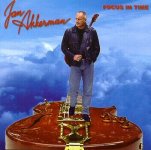Stinius, interesting and memorable encounter I guess. Must have been fun. Jan Akkerman still tours in Holland and the rest of Europe with his own band. The main reason he left Focus, was because he and Thijs had different ideas about the musical direction of Focus. Jan wanted to explore and play new things and staying with Focus somewhat limited his development.
When I was about 16 years of age (some time ago 😉 ), my elder brother (no longer with us) brought home a record from Focus. That is how I fall in love with their music and still today enjoy Jan Akkerman's talent. He also has his own website.
Regards,
Franklin
When I was about 16 years of age (some time ago 😉 ), my elder brother (no longer with us) brought home a record from Focus. That is how I fall in love with their music and still today enjoy Jan Akkerman's talent. He also has his own website.
Regards,
Franklin
I would appreciate it, if I knew who you were talking about, but I have heard 'Focus' at an earlier time.
John, if you google for Focus (the band), you'll find lots of information and even youtube Focus concerts.
Enjoy.
Regards,
Franklin
Enjoy.
Regards,
Franklin
courage said:
Reminds me of Jan Akkerman (well known Dutch guitar player) who seeks for this one moment when he plays, where everything falls into place. According to him it occurs every once in a while.
Enjoy ...
Franklin
I think it happens more than once in a while for him. Akkerman is
a genius.
T
john curl said:Well, what is next?
Well John, earlier in this thread I presented three possibilities for the servo-out return point (on the open-loop stage also presented many times in this thread), but never got a response. Now if I simulate al three possibilities they are more or less working very well. The point is, what is sound-wise the best choice for this particular topology?
Regards,
Franklin
I remember that Franklin is obviously very interested in this issue. Too much "realworld" question, Franklin 😉
Franklin, I do not discuss how I return the servo on the Blowtorch circuit. However, several approaches will work, some better than others.
It is important to understand that the SPECIFICS of circuit design are less important than the PHILOSOPHY of circuit design. There are many ways to make a design operate within specified parameters. Just yesterday, I worked all day with another engineer to make audio circuits with various IC's, so that they perform in a special way. We tried several manufacturers and tried several circuit configurations. The real problem is to decide which was really works best, not just for measurement, but aligned with what the human ear detects. One factor that I look DEEPLY into, is the generation of 7th harmonic distortion in the circuit.
This gives me a good indication of the open loop linearity of the circuit design. Kinks in the transfer function concern me. The absolute value of non-linearity is less important.
This gives me a good indication of the open loop linearity of the circuit design. Kinks in the transfer function concern me. The absolute value of non-linearity is less important.
PMA said:I remember that Franklin is obviously very interested in this issue. Too much "realworld" question, Franklin 😉
Pavel, I'm always eager to learn; realworld or not ... ;-)
john curl said:Franklin, I do not discuss how I return the servo on the Blowtorch circuit. However, several approaches will work, some better than others.
John, I have never seen or heard the Blowtorch nor it's topology, so my question concerns the topology presented here (which according to you was NOT the BT). If however you unconsiously admid it is the BT, than that is something different; so what philosophy lies behind the best servo return point?
Franklin
I gave our hifi community a task to tell differences between several 16/44.1 wav files. They did not find the difference between original file and file distorted by 2H -26dB, 3H -46dB and 5H -60dB (Keith Howard AddDistortion SW). They easily told the difference between the files where the only difference was LM4562 vs. OPA2134 exchange, however. The guys with purely engineering approach are having problems with that.
People with a purely THD approach would have problems with that.
Was there an op-amp preference expressed?
Was there an op-amp preference expressed?
PMA said:I gave our hifi community a task to tell differences between several 16/44.1 wav files. They did not find the difference between original file and file distorted by 2H -26dB, 3H -46dB and 5H -60dB (Keith Howard AddDistortion SW). They easily told the difference between the files where the only difference was LM4562 vs. OPA2134 exchange, however. The guys with purely engineering approach are having problems with that.
If you are referring to your post 17108, I thought the second file sounded better listening through my low-fi computer speakers. Didn't try the third file in a later post.
traderbam said:People with a purely THD approach would have problems with that.
Was there an op-amp preference expressed?
Yes, it was the OPA2134.
Interesting input PMA.
As far as servo return is concerned, the less attachment to the input stage the better. I hope that helps.
As far as servo return is concerned, the less attachment to the input stage the better. I hope that helps.
john curl said:Interesting input PMA.
As far as servo return is concerned, the less attachment to the input stage the better. I hope that helps.
Ok, that gives me something to ponder on and see (hear) what difference in makes in the real world.
- Status
- Not open for further replies.
- Home
- Amplifiers
- Solid State
- John Curl's Blowtorch preamplifier
